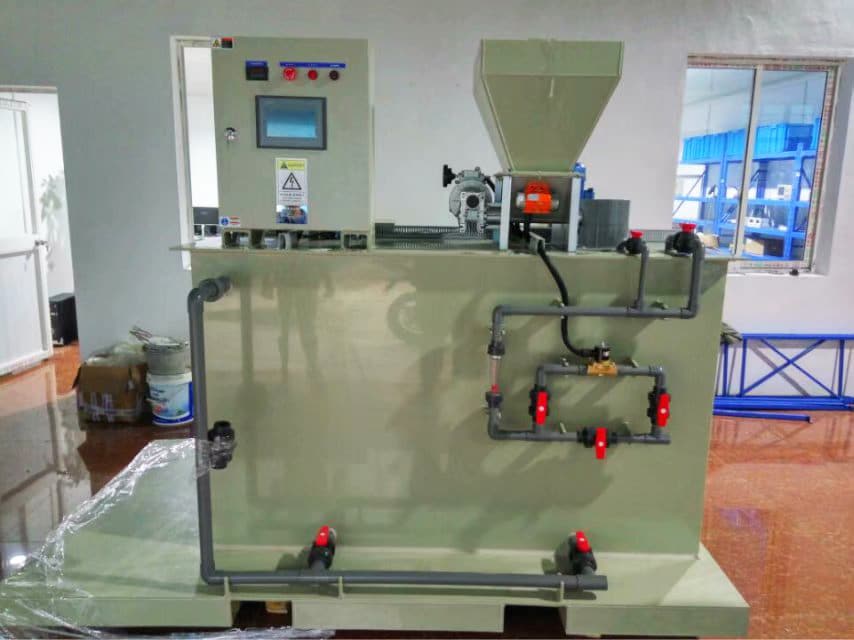Polymers are widely used in wastewater treatment to remove suspended solids and pollutants from water. They are often used in municipal, industrial and stormwater treatment systems.
Solid-liquid separation, which once took days or even months, can now be accomplished in a fraction of the time by preparing, activating and applying polymers. Effectively helping to purify wastewater, saving time, money and energy.
What is a polymer?
Polymers are molecular chains composed of smaller molecules of monomers. The monomers come together to form chains, and the monomer chains are called polymers, also known as macromolecular compounds. There can be millions of monomer molecules in a polymer, and the more monomers there are, the longer the polymer chain.
Next, we will focus on polymers in industry – specifically polymer water treatment.
Types of water treatment polymers
Anionic polymers in water treatment
Anionic polymers have a negative charge. They are particularly suitable for flocculating inorganic solids from waste liquids, such as clay and silt. Therefore, they are often used in wastewater from heavy industries such as mining and sand and gravel.
Cationic polymers in water treatment
Cationic polymers have a positive charge. Ideal for removing organic solids such as human excrement, animal manure and plants from wastewater. Municipal wastewater treatment plants, agricultural and food processing facilities often use cationic polymers.
Anionic and cationic polymers can also be divided into two other categories based on their form and delivery method.
Liquid polymers in water treatment
Liquid polymers are also known as emulsion polymers because they are added to the wastewater in the form of many small droplets that are insoluble in a water mixture. This type of polymer has a lower concentration of active molecules than dry polymers, which means that the effectiveness of the treatment is diminished by the method of delivery.
Liquid polymers may be a more cost-effective option if sourced locally, as they can be purchased at a lower price than dry polymer options.
Dry polymers in water treatment
Dry polymers contain a much higher concentration of active molecules. This makes the dry option a more effective flocculant than liquid or emulsion polymers.
In general, dry polymers can be more expensive, although shipping and logistics costs may be lower. For larger scale flocculation projects, dry polymers are often preferred. However, dry polymer systems typically have higher upfront equipment costs than liquid polymer systems.
Polymers in waste water treatment
Polymers separate solids from liquids through a process called flocculation. These specific water-soluble polymers are called flocculants or polymeric flocculants. The ability of polymers to flocculate solids is critical to their role in water treatment. While they work alone, they can also be used in combination with coagulants to achieve better results.
Most industrial process water or wastewater contains negatively charged sediments and particles. The negative charge around each particle prevents them from clumping together and forming a colloidal dispersion. Negatively charged particles do not clump together and float in liquid suspensions for hours, weeks or even years. The coagulant added to the muddy water creates a coagulation process that neutralizes the negative charge of the particles. Once neutralized, these particles clump together to form larger particles called microflocs or needle-like flocs.
As the settling process continues, sludge forms at the bottom of the container holding the wastewater. This sludge accumulates in settling tanks, sludge ponds, clarifiers or thickeners. Once sludge is formed, it can be managed and disposed of by different methods.
Coagulants and flocculants are not only used to dislodge the sediment from the liquid suspension. Because of their ability to neutralize and coagulate colloids, these chemicals also support dissolved air flotation (DAF) systems. In DAF applications, microbubbles pull the solids to the top of the tank where a skimmer removes them.
In addition to separating solids from liquids, they help thicken sludge and dewater contaminated material for treatment and disposal. Removing water from waste sludge can change the nature of the waste from a liquid to a solid waste, significantly reducing the cost of sludge treatment.
Industries that use polymers for wastewater treatment
Polymers are used in all industries where solids need to be removed from waste water streams.
Aggregate producers use water to wash sand and gravel. During the washing process, the wash water picks up dirt, clay and silt. In order to reuse or safely discharge this wash water, the solids need to be separated from the water.
Sedimentation tanks are often used to contain the wastewater and settle it. It can take a long time for the sediment to fall out of the liquid suspension. Aggregate producers must stop production while they clean the ponds and wait for clean water. These stoppages result in lost production time and increased labor time for the producer.
However, polymers can significantly improve the settling rate of aggregate wastewater. By using polymer dosing systems, producers can inject polymer solutions directly into their settling ponds. Polymer dosing improves settling rates, provides clean water, and thickens the sludge at the bottom of the pond for easier management and disposal.

Many operations also use polymers to prepare wastewater prior to mechanical treatment in clarifiers, thickeners, filter presses, screw presses, centrifuges and other dewatering equipment.
Not all wastewater treatment polymers are created equal. Select a specific chemical depending on the wastewater and operational needs. The right type of polymer will help you meet regulatory requirements, save money and improve operational success.
